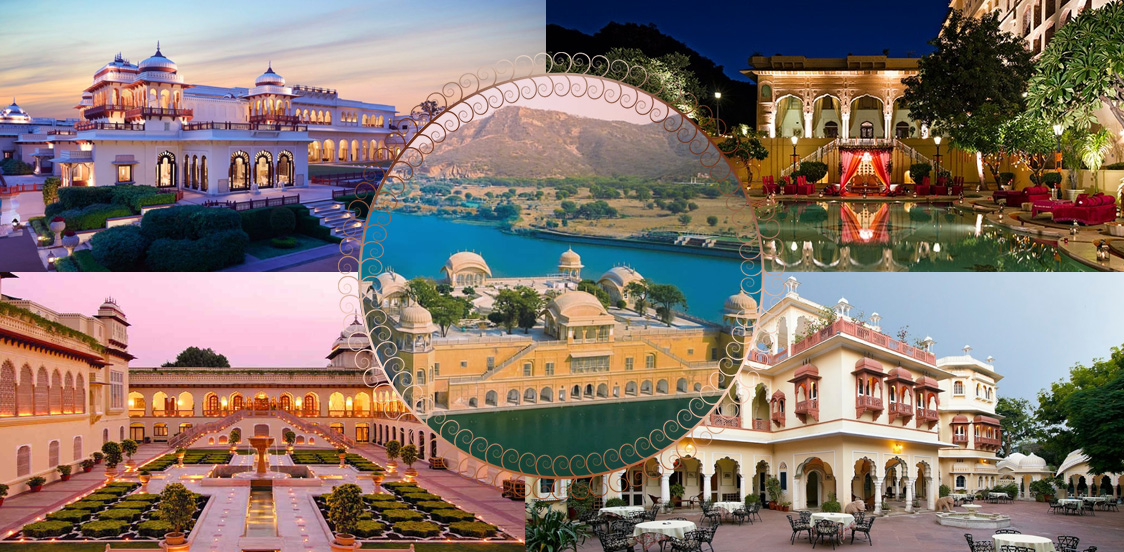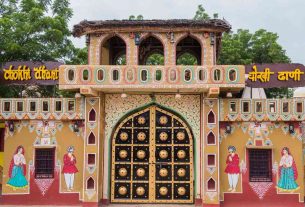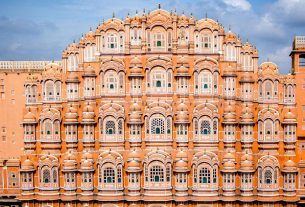Rajasthan is the land steeped in the glory of royalty. Every fort, palace or monuments have the charm to entice every eye. A similar interesting constant feature that catches our attention is the Havelis in Jaipur. These Havelis in Jaipur are the most prominent facets of the remaining instances of the state’s rich architectural heritage. Have you ever stayed in a traditional Haveli in Jaipur? What’s there in a haveli that makes it an important part of Jaipur’s built and cultural heritage? Let’s dig a little deeper and know everything about Havelis in Jaipur.
Table of Contents
The Havelis in Jaipur
Rajasthan has got its name after the kings(Raja) who were also the brave soldiers. They have created spectacular buildings where they used to stay popularly known as Havelis. These Havelis in Jaipur are basically the traditional courtyard mansions belonging to royal families as their residential units. These square or rectangular-shaped courtyard structures are hard to miss for they can be found all around the scintillating bazaars of Jaipur. Most old Havelis can be found in the walled city area having a historic significance.
Architecture of Haveli
The heritage Havelis of Jaipur carries the past with it and without them still erected gloriously, the reminiscences would have diminished by the urbanization. When it comes to the preservation of culture and architecture, the Rajasthan Tourism and Urban Development Ministry should be given the credit for the conservancy. Let us know more about their architecture.
The architecture of these Havelis has many interesting features. These Havelis were accentuated with marble flooring, pillars, carvings, antique implements, and paintings found even in the tiniest of rooms. The marble flooring was done with striking Araish work which forges white marble with a near mirror finish. Their stepped terraces, multiple courtyards, well-defined chowks, lattices, intricately designed Jharokha, Tibara define the bygone era. The architecture style of the Havelis is distinctly curated, influenced by the local climate, social structures, customs, and traditions. Along with the customs and traditions, the Haveli architecture style also varied depending on caste and social structure along with the location.
Architecture reflecting status
There was a drastic difference between the Havelis of nobles, Rajputs, aristocrats and those of merchants, Brahmins, and common people.
- Land and area: Also, people were assigned land, based on their professions. Bigger land at strategic locations was given to important people like officials and wealthy businessmen.
- Number of Courtyards: The social status and influence of a person were assessed by the number of courtyards in his mansion. Some of the Havelis had up to seven courtyards that reflected their social reputation.
- Number of Clusters or wings: The clusters in a haveli structure demonstrated the status of a family. The Havelis were basically divided into two clusters, the single-family cluster and the servant cluster. Amid these two clusters lies a thin female wing, a waiting area secured for the house’s attending ladies. The status of the family was defined by the number of clusters in their haveli; the one with higher status had more clusters.
Architecture reflecting climate
As Jaipur is very hot most of the time in the year. The architecture of Havelis was focused to keep the atmosphere cool.
- Courtyard: The courtyard or chowk represents an essential element in all such structures. The courtyard is an enclosed space from all four sides but is open to the sky allowing sunlight, air, and water.
- Jharokha or Verandah: It is a protected place for shade, sun, light, and breeze. Jharokha is on the upper floors and is also meant to shelter from the rains. While a partly shaded or open place, Verandah is placed on the ground floor.
- Facade: The closer-knit structures curtail uncovered external areas of haveli to sun and heat, drawing the cool air. Since there are tall buildings on either side, the air that passes through the facade from the street is much cooler than the air exposed to the sun. The front facade of the Havelis lets the cool air enter through it, circulates through the rooms and then escapes out from one of the courtyards carrying out the hot air along with it.
- Walls and Roof: The walls and roofs constructed had good thermal resistance to protect from the hot climate. The small size openings on the outer face of buildings cut out the harsh sun and hot winds also help to enhance privacy.
- Openings: An important feature of the Havelis in walled cities is they are full of openings. From a sequence of windows to intricately carved stone Jalis, these different sizes of openings allow the passage for cross ventilation.
- Jalis: The latticework Jali blocks the direct rays of the sun and yet permits air to enter the room and is designed to grant privacy.
Architecture of the Havelis reflecting values and customs:
- The courts were the centers of life in these Havelis. The front courtyards or chowks were used by men and were a public area. While the ones in the back were private usually for women and children. They used to spend their time there, hidden from the outsiders. The courtyard serves many purposes like a centre for various rituals and household activities and worship of tulsi plants.
- Another feature was the entrance doors of the Havelis. These wooden doors were huge enough and were only opened on special occasions. For other times, there were small openings attached from the large gate. These gates were also constructed to safeguard from invaders.
These masterpieces still carry the age-old charm. One can’t miss the spectacular sight of these Havelis passing by the lanes of Jaipur. However, many of them are losing their elegance due to many socio-economic reasons.
Havelis in Jaipur that are on their way downhill
The beautifully Havelis built centuries ago are an integral part of Jaipur heritage, a priceless architectural legacy that influences thousands of travellers to the pink city, making the city proud. Of the many Havelis in Jaipur, some Havelis have now been renovated and converted into hotels granting them a new lease of life. While many of them are left on their own and their beauty is slowly being eroded due to a lack of attention and maintenance. Here are the reasons eating away the beauty of the Havelis in Jaipur:
Lack of technique
It is unfortunate that the facade of the Havelis in Jaipur is being pulled down or is being fortified frequently. However many of them underwent restoration but are still not in line with local architecture style. This is because most of the Havelis or old structures were constructed using ancient techniques and a uniform colour like lime plaster and local stones. But, these days it is hard to find skilled people proficient in this technique. And the use of universally available construction material in heritage Havelis are losing their traditional character. For instance, the government rule restricts the colour of the facades to be done uniformly with terracotta pink. Hence to ensure uniformity, the work should be carried out by the local authorities. But The pink colour done today is distinctly different from the hallmark terracotta pink that used to be in the walled city area.
Demolishing the Havelis
Most of the old Havelis are being razed down to be replaced by modern buildings. The residential possessions are being reinstated with a commercial complex. This not only adds to losing the pricey heritage but increasing commercial activity in the walled city is also giving rise to traffic congestion. A big rush towards commercial spaces and each additional commercial complex puts a burden on existing infrastructure. This is mainly due to the fact that despite stringent laws that do not permit the destruction of historic architecture, the influential people manage permission from the authorities to falsify laws and rules. The old facade has been replaced and has given way to modern-looking buildings.
Although some gems are falling prey to neglect and apathy, Fortunately, some Havelis found new investors and have been restored now and turned into heritage properties. They have been beautifully restored in a manner that their old magnificence is still intact. One may feel a sense of marvel while glancing at these spectacular Havelis.
Best way to experience the traditional Havelis in Jaipur
To explore the Havelis in Jaipur you can either take a walking tour or stay at an authentic haveli. As for a walking tour, you can go through a heritage walk in Jaipur. You can also initiate a walking tour on your own as you will find Havelis in most of the lanes of the bazaars in Jaipur.
While the best way to experience and live the grandeur is through staying in an authentic Heritage Haveli. Staying in one feels like you’re staying in a breathing museum. Fortunately, there are a few authentic Havelis to stay in Jaipur that have been turned into a hotel and are open for travellers. These haveli hotels run much like how it was in Jaipur’s imperial history, with the owning family in its cluster, the guests in another, and the attending staff in another. These Havelis are managed by the haveli-owning family which lives in the haveli, as well. At times, guests can also enjoy a meal with the owning family.
A stay in Jaipur Havelis will definitely be a good choice to witness and experience a remarkable culture. Many Havelis are passed down through generations and these heirlooms are a reflection of the yesteryear grandeur and provide a great medium to study the evolution of society and its practices. These Havelis are hotels that have been restored out of residences of Royal family members and staying in a haveli is one of the rare opportunities to feel like you are stepping back in time.
Top 5 Havelis in Jaipur to Stay
These are the top 5 havelis in Jaipur where you get to stay with the family. Although there are many other Havelis in Jaipur to stay, these are the few that give you the authentic taste of luxury living.
Jaipur Haveli
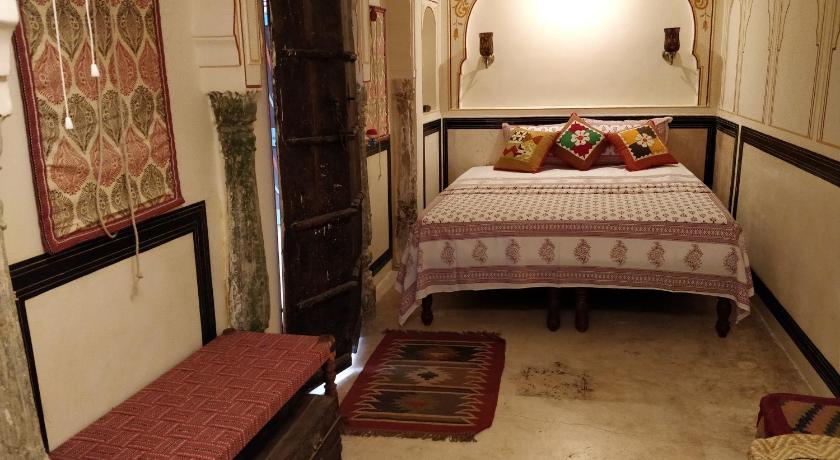
Nowadays, many Royal mansions in the city are transformed to heritage hotels, and Jaipur Haveli is one of them. It is a newly begun lineage homestay located in the middle of the city at Johri bazar keeping most of the tourist destinations at walking distance only.
History of Jaipur Haveli
This haveli was built in 1744 which signifies that it is as old as the Jaipur city. The owner of this beautiful mansion is Praveen Seth (Bauji) and his son Vikram Seth. It all started when the Great Grandfather of Vikram Seth shifted from Patna to Jaipur because of the epidemic in 1910. He got popular in Jaipur as a Diamond Jeweller. His popularity brought traders from Turkey to Jaipur to buy his jewellery. It was in 1921, the Seth family bought this haveli in a worn-out condition. It took almost a year and about 40 construction workers to get the Haveli ready. The haveli became the home to Seth family in 1922. The idea of transforming it into a hotel striked the owner when Vikram got married in 2006 and 45 guests stayed in Haveli.
Highlights
The old Mansion is restored with minute detailing to almost everything. From furniture to carpets everything is precisely revived for an impressive experience for all. The attractive tough wooden doors are ancient from the early era, still holding the old locking technique. A small porch with a garden, a rare scene in a walled city welcomes you to this beautiful haveli. The pink colored facade of the Haveli, walls with intrinsic details of Royal guards and the fresco work have a century old traditional architecture with their originality intact.
Entrance gate to the first courtyard is designed in old Rajput style with a Gokha (sitting place on both sides of the gate). The stone paved courtyard with vintage mirrors and a Divan Bed gives it a classic look. The entrance to the second courtyard has original paint works on the gate with symmetrical paintings that are mesmerizing.
Of the 22 rooms in the mansion, 8 rooms are open for tourists. These rooms are decorated with authentic murals and paintings and vintage looking furniture, which gives guests a Maharajah feeling. Bathrooms are restored using Traditional Blue Pottery. Private rooftop space is provided for the guests to relax. The guests also have access to a private collection of the Family’s age old pictures and artifacts of gems and jewelries.
The family also welcomes every tourist in celebrating fairs and festivals, letting the guests witness the city’s culture. The owners treat the guests as family members and serve them traditional home cooked vegetarian food to experience the city’s local life.
Address: 1404, Tarachand Nayab, Bordi Ka Rasta, Johri Bazar, Jaipur
Samode Haveli
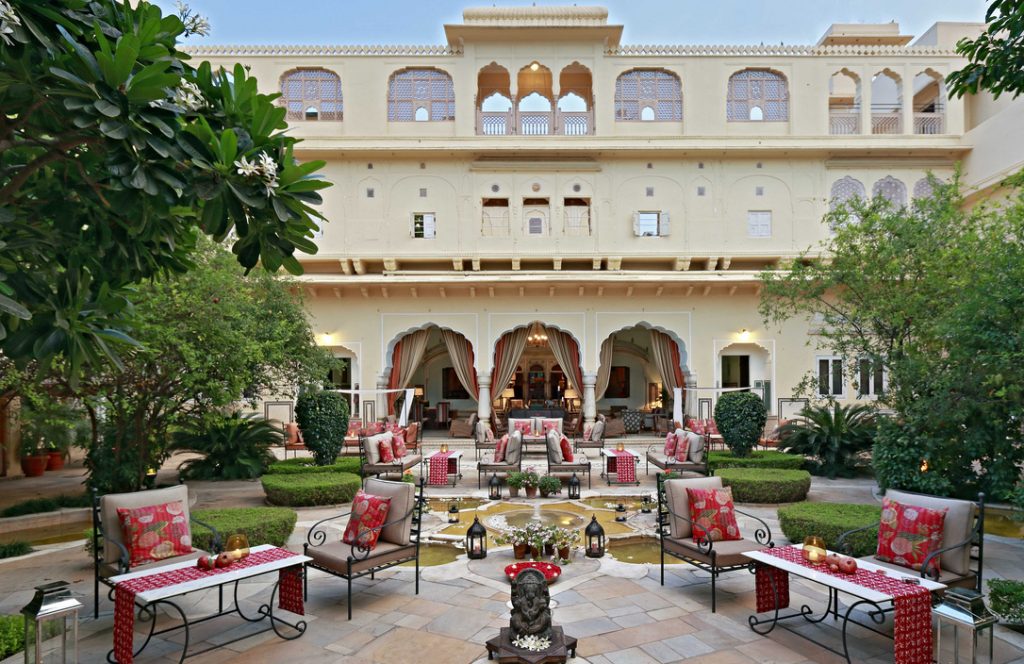
Jaipur has an incredibly long and rich history and exploring its ancient havelis is truly a delight. The Samode Haveli is one of finest heritage haveli and a major attraction of Jaipur. One of the most stunning, historical and fascinating Samode Haveli is flamboyant, grand and regal.
History of Samode Haveli
Built by Jaipur’s former prime minister Rawal Sheo Singh Ji about 225 years ago, Samode Haveli is truly a spectacular regal beauty. This majestic old mansion is one of the ancient buildings of the ‘Pink city’. Rawal Sheo Singhji belonged to the Samode family hence the haveli is named Samode Haveli. This alluring haveli is festooned with elegant courtyard, gardens and terraces. The inner courtyard of the haveli was used as the manor house of the royal family of Samode.
Highlights
With incredible frescoes and murals, and a lush green garden, the Samode Haveli carries a warm and decent atmosphere, with. All corners of this structure are adorned with affluent artworks. At the entrance is an elephant ramp, the dining rooms have admirable paintings with intricate detailings, and the courtyards and verandahs are breezy and refreshing. The arworks, the precise detailings, the antique furniture showcase the luxurious life the kings used to live. The haveli exists as a symbol of the impressive and regal past of the Samode family. While exploring Samode Haveli you will have a glimpse of the blue pottery as well as hand block printed textiles that are handcrafted from the local craft market.
Address: Jorawar Singh Gate, Gangapole Road Near, Gangapole, Jaipur
Royal Heritage Haweli
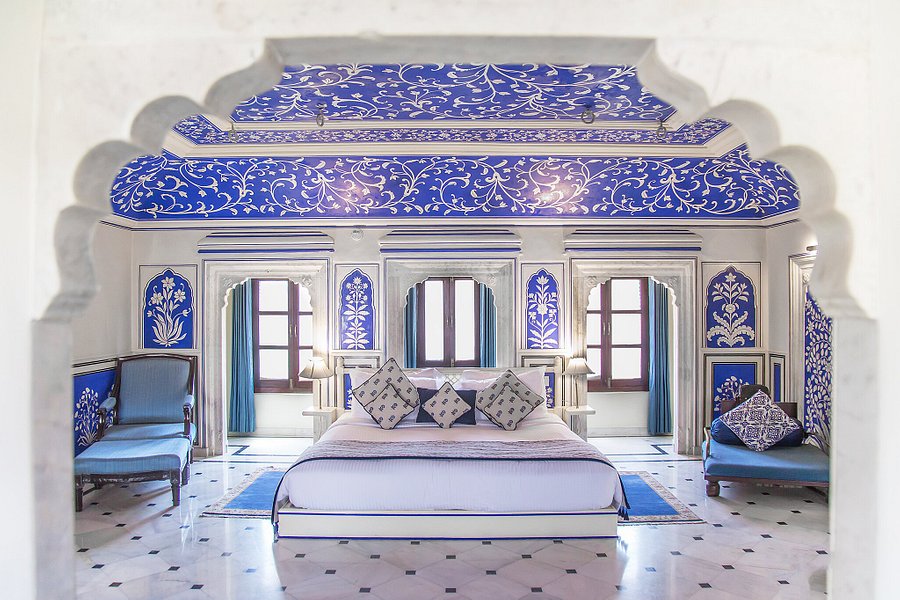
This heritage haveli stay is a unique and beautiful mansion in Jaipur which gives you a chance to witness the rich culture of Rajasthan and its warm hospitality. This beautiful homestay may only be a short distance from the city centre, but it’s a world away from all the noise and bustle.
History
Royal Heritage Haveli is an 18th-century structure built by Jaipur’s His Highness Madho Singh Ji. This was initially erected as a hunting lodge, and after 200 years this beautiful mansion opened its doors for the tourists as a boutique hotel. Maharaja Jai Singh of Jaipur is now the owner of the Royal Heritage Haveli but it is run by his niece and her husband, Angelique and Pradeep. They are known for their delightful hospitality, they ensure that each guest experiences a personalised and authentic taste of the bygone era of the Maharaja’s lifestyle.
Highlights
A remarkable hotel, the Royal Heritage Haveli boasts meandering lawns, tranquil courtyards, plush interiors and grand living areas. This glorious haveli has eighteen suites and one apartment that teams up the romantic elegance of classic Jaipur along with the luxury to provide a serene haven of space and indulgence to the selective few. Every room offers its own unique charm with distinct artworks and artefacts. This is your Rajasthani retreat throughout your stay!
Royal Heritage Haveli Jaipur is the epitome of rich tradition and generosity. Guests feel mesmerized by its magnificent living rooms and state-of-the-art architecture. This elite class authentic heritage haveli turned hotel offers the solace and delight which is unmatched in any of the hotels in Jaipur. Its world-class services and extravagances are there to ensure the guests’ affluent stay. Escape the monotonous with exceptional hospitality, polished over generations at this authentic Haveli in Jaipur which is worth staying in. Dine like a Maharaja, appreciate a serene corner of the courtyard gardens where you can reflect and unwind.
Address: Plot No. 116 & 117, Near Khatipura Tiraya, Khatipura, Jaipur
Alsisar Haveli
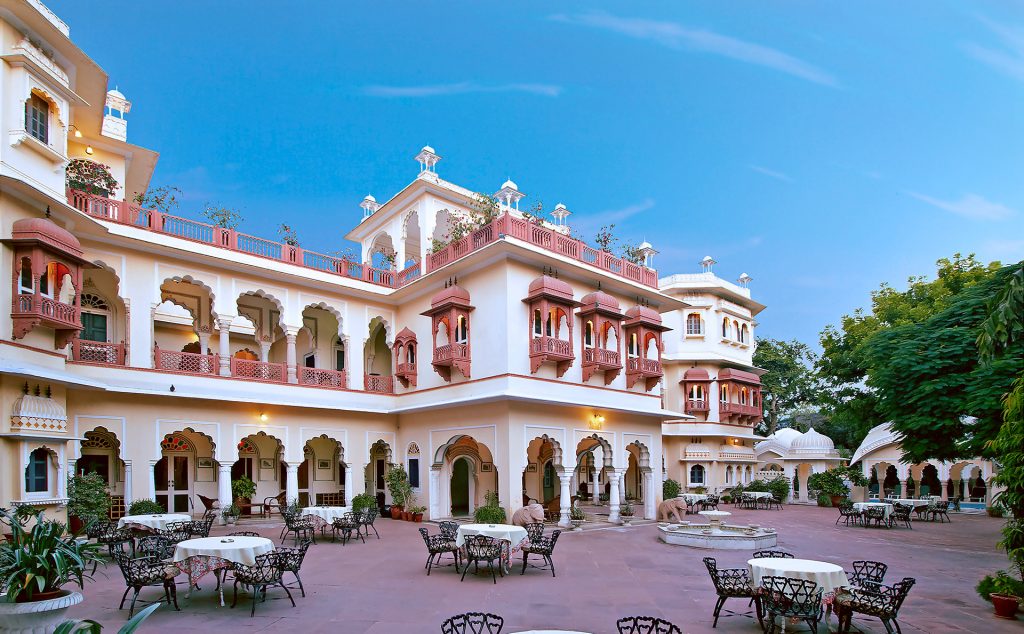
It is a heritage property tucked in the heart of Jaipur city. Alsisar Haveli, also known as Asisar Mahal is of the rich inheritance of the Shekhawati region. This haveli is recommended for all travellers looking for authentic heritage haveli acquaintance.
History
The history of Alsisar Haveli dating back to the 18th century features the glorified past of Rajput and the luxuries of Rajasthan. This elegant Haveli built in the year 1862 was owned by Rajput’s Kachawa clan. It is a gem of the past that brings out a regal experience for the guests.
Highlights
Alsisar Haveli is one of the most authentic heritage hotels in Jaipur with stunning architecture and beautifully adorned interiors. Every corner of this haveli speaks history and keeps the guests captivated. The place was refurbished taking care of the precision of the original glory that once used to be. The central area of the ground floor of this haveli is the highlight as it is situated at a large elevated platform. This area was once used for a get-together by the gentlemen of the house and is now used for hosting puppet shows and folk dances for guests. Traditional wall paintings accentuate the look of the walls of this haveli. These wall paintings are age-old with definitive colours and patterns. The interior of the haveli displays a Rajasthani vibe with antique furniture and medieval Rajasthani style fabrics. The historic Alsisar Haveli has 45 heritage style state of the art rooms that have the charm of old times. All the rooms are well furnished and modern amenities but with an impression of royal indulgence which the Maharajas of Jaipur used to have.
Address: Sansar Chandra Road, Shri Ram Colony, Sindhi Camp, Jaipur
Mandawa Haveli
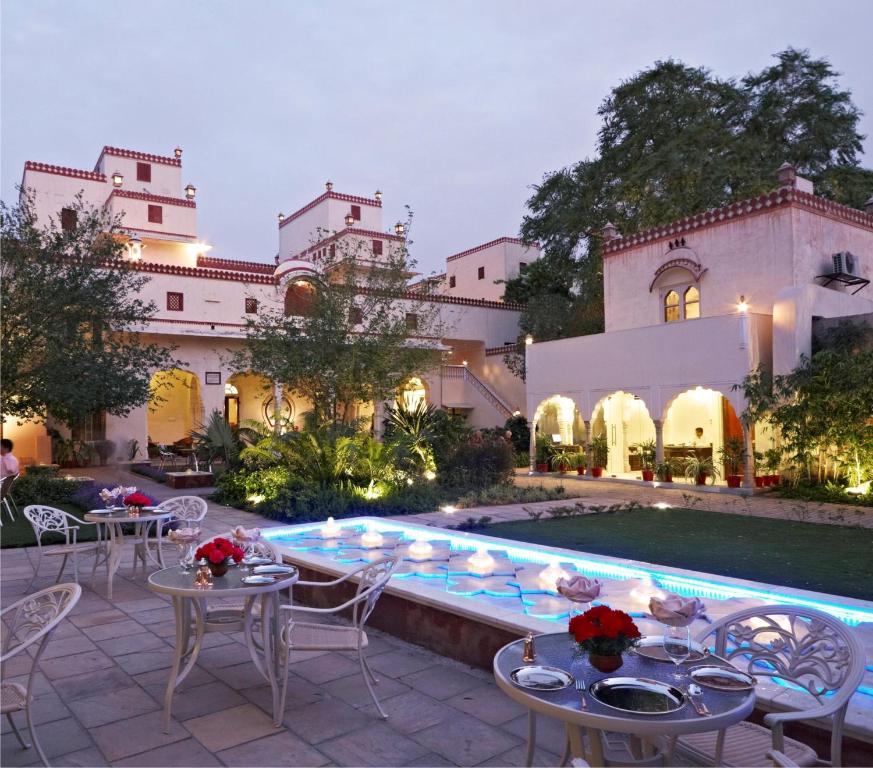
Mandawa Haveli is a heritage haveli style located in the busy area of MI Road. This Haveli offers guests a charming heritage stay and a convenient base to explore Jaipur. This haveli offers a great view of Nahargarh fort from its terrace.
History
The Mandawa Haveli Jaipur was created by Thakur Bhagwat Singhji, the 15th ruler of Mandawa in 18 century. This Haveli is located in the Shekhawati region of Jaipur and was ruled by the Kachhawa Rajputs clan. Standing amidst modern-day Jaipur, this heritage havelis marks its noble presence. A stay here is nothing short of kings’ life.
Highlights
The Mandawa Haveli is curated in Jaipur style of architecture having numerous pillars and arcs and is richly carved. It is decorated with the fascinating and impressive paintings of Lord Krishna and his cowsheds. The beautiful Mandawa Haveli has a different theme for its different wings. It has seventy spacious rooms adorned with intricate wall paintings and mirror work. It also has several courtyards and an open terrace, providing a panoramic view of the entire Shekhawati. Once used to be ‘darwar’ is now transformed into an exotic lounge. It is bedecked with affluent paintings and preserved antiques. You get an opportunity to witness all the precious belongings of the royal family in the museum here. They are still preserved in the showcase intact. The valuables include ceremonial costumes, precious arms with the handle of jade, gifted by the British. You will feel the royal ambience of those years still lingering in the room.
Address: Sansar Chandra Road, Pink City, Jaipur
These authentic havelis of Jaipur let you experience the old world charm and the lifestyle of Royals. Living in one of these will make you feel like a Royal treated with utmost luxury and impeccable generousness.
